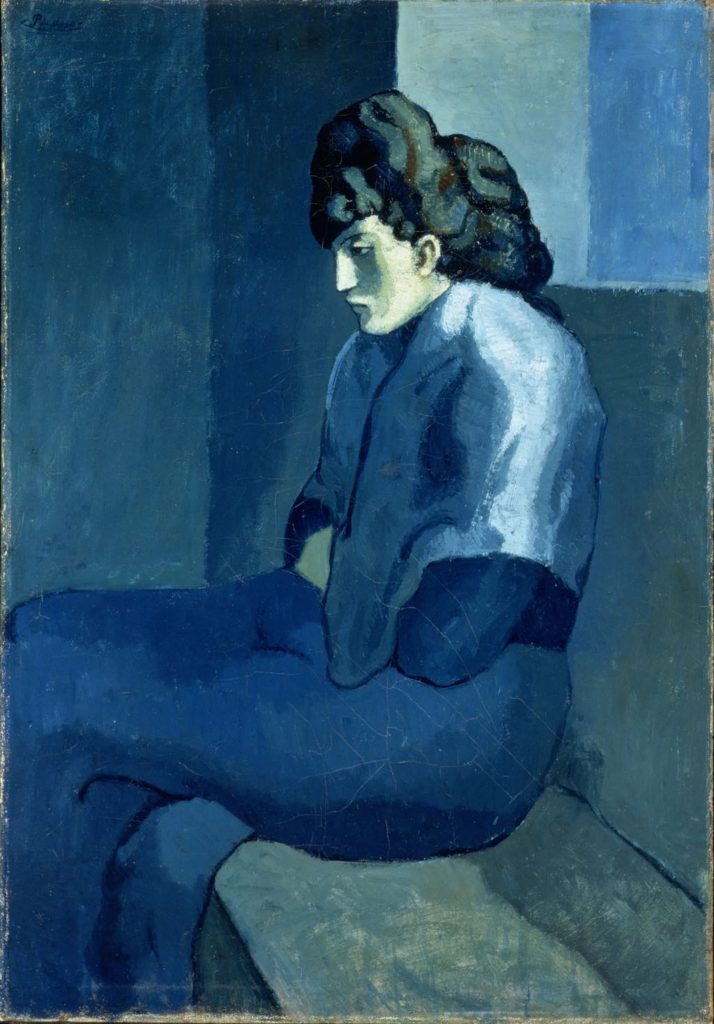
Just as I was going into the exhibition “Picasso: Bleu et Rose” at the Musée d’Orsay, a man who was on his way out said to me: “I envy you. You’re going to have a wonderful experience.” His face was aglow after worshipping at the Church of Picasso.
I am more of an agnostic than a true believer, but the exhibition won me over; it is always fascinating to watch the development of an artist, especially this artist, from the early, floundering, imitative stages to the budding of his mature style.
The young Picasso, torn between the academic painting he had mastered so well under the tutelage of his artist/teacher father, and the avant-garde trends he encountered in Barcelona, went to Paris for the first time in 1900. There he encountered all the exciting new artists and movements that were blossoming in the French capital at the turn of the century.
As a preface to the two periods in question, we are shown several self-portraits demonstrating how the Spanish prodigy mastered different idioms with panache. In “Self-Portrait in a Top Hat” he pays homage to Toulouse Lautrec, while “I, Picasso,” with its brilliant colors and swift, short brushstrokes à la Van Gogh, self-confidently presents the artist to the world as a romantic figure.

Later that same year, 1901, following the suicide in February of his dear friend Carles Casagemas, which triggered Picasso’s depression and the gloomy paintings of the Blue Period, another self-portrait shows Picasso looking gaunt and somber in a black coat, the grayish-blue of the background reflected in the drawn features of his face.
All three of these very different paintings were made in 1901. Five years later, in 1906, we find a totally new Picasso, face depicted like a mask (pictured at top of this page), under the influence of African art, which would mark his work in the coming few years as he headed down the road to Cubism and the rest of his long career.

The Blue and Rose Periods fell in those five years between 1901 and ’06. The exhibition treats the Rose Period not as a separate phase but as a continuation of the Blue Period as Picasso’s depression lifted. The first picture in the show, “Lady with a Fan“ (1905), is an example of the mingling of the two periods. The painting belongs “neither to the tragic world of the Blue paintings nor to the world of the acrobats of the Rose Period.”

The Blue paintings are sad not only in their grim colors but also in their subject matter: the title of “Melancholy Woman” (1902) is self-explanatory, for example. Death, misery, blindness and poverty predominate in these paintings, but a series of erotic sketches from this period provides a contrasting sidenote – Picasso may have been depressed, but he seemed nonetheless to have had a lively sex life (he depicts himself in some of these works) at the time.

In 1905, his palette became more varied and pinker, although he continued to depict tragic subjects (even the acrobats and other performers look miserable), but eventually, a turning point came as Picasso began to look toward Antiquity for inspiration and to simplify the forms in his paintings and restrict his palette to shades of ocher. He was off in new directions, leaving the blues behind.
Although the Blue and Rose Periods have been treated in many exhibitions, it is still a pleasure to see these works again for regular museum-goers and, I imagine, for those who have never been introduced to the artist’s early years.
While he may not have been a god, Picasso was a prodigious master and this is a prodigious show.
If you enjoyed this article, you might also be interested in “Giacometti” at the Musée Maillol or “Miró” at the Grand Palais.
Favorite
